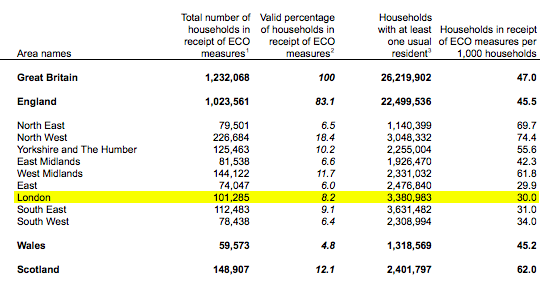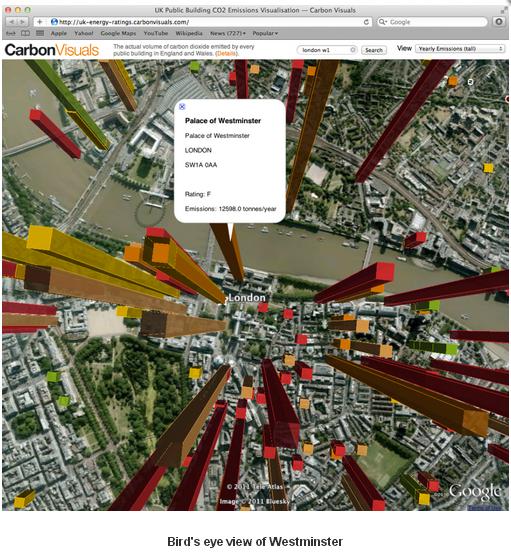Site search:
-
What’s new?
Energy for London Tags
Brent Buildings Camden Carbon Emissions CHP Cities Climate Adaptation Community Heating Community Initiatives Croydon Data DECC Decentralised Energy Distribution ECO Energy Costs Energy Efficiency Enfield FIT Fuel Poverty Funding Green Deal Hackney Haringey Housing Islington Lambeth Library Local Authorities Mayor Newham Ofgem Olympics Photovoltaics Planning RE:FIT RE:NEW Renewable Energy Retrofit Southwark Tower Hamlets Transport Waltham Forest Waste WestminsterEnergy Archives:
- February 2021 (1)
- January 2021 (15)
- December 2020 (15)
- November 2020 (9)
- October 2020 (3)
- August 2020 (5)
- July 2020 (3)
- June 2020 (4)
- April 2020 (10)
- March 2020 (5)
- February 2020 (2)
- January 2020 (3)
- October 2019 (1)
- September 2019 (4)
- August 2019 (2)
- July 2019 (1)
- August 2018 (1)
- November 2016 (8)
- October 2016 (8)
- September 2016 (2)
- August 2016 (8)
- July 2016 (14)
- April 2016 (12)
- March 2016 (16)
- February 2016 (8)
- January 2016 (4)
- December 2015 (1)
- November 2015 (1)
- October 2015 (16)
- September 2015 (3)
- June 2015 (1)
- May 2015 (1)
- April 2015 (1)
- March 2015 (1)
- February 2015 (1)
- January 2015 (1)
- December 2014 (18)
- November 2014 (4)
- August 2014 (8)
- July 2014 (7)
- June 2014 (25)
- May 2014 (8)
- April 2014 (4)
- March 2014 (12)
- February 2014 (7)
- January 2014 (13)
- December 2013 (11)
- November 2013 (15)
- October 2013 (15)
- September 2013 (18)
- August 2013 (5)
- July 2013 (20)
- June 2013 (33)
- May 2013 (8)
- April 2013 (16)
- March 2013 (25)
- February 2013 (14)
- January 2013 (20)
- December 2012 (23)
- November 2012 (23)
- October 2012 (25)
- September 2012 (14)
- July 2012 (12)
- June 2012 (43)
- May 2012 (20)
- April 2012 (8)
- March 2012 (40)
- February 2012 (39)
- January 2012 (40)
- December 2011 (22)
- November 2011 (40)
- October 2011 (33)
- September 2011 (48)
- August 2011 (40)
- July 2011 (58)
- June 2011 (41)
- May 2011 (80)
- April 2011 (38)
- March 2011 (33)
- February 2011 (25)
- January 2011 (24)
- December 2010 (3)
- November 2010 (7)
- October 2010 (6)
- September 2010 (7)
- August 2010 (1)
- July 2010 (2)
- June 2010 (4)
- May 2010 (1)
- March 2010 (3)
- February 2010 (3)
- December 2009 (5)
- November 2009 (2)
- October 2009 (3)
- July 2009 (3)
- June 2009 (1)
- April 2009 (1)
- March 2009 (1)
- February 2009 (1)
- January 2009 (1)
- December 2008 (2)
- October 2008 (1)
- September 2008 (1)
- July 2008 (1)
- March 2008 (2)
- January 2008 (2)
- October 2007 (1)
- September 2007 (3)
- July 2007 (1)
- March 2007 (1)
- February 2007 (3)
- November 2006 (3)
- August 2006 (1)
- February 2006 (1)
- May 2005 (1)
- February 2004 (1)
Uncategorized
Energy and Climate Questions to the Mayor
September 2016: This month Mayor’s Question Time included the following:
progress on Energy for Londoners; schools and community energy; schools and solar power; cost to business of poor energy efficiency; renewable energy potential on TfL land and buildings; solar on London Overground land; energy efficiency and private rented sector; a discussion on Energy for Londoners; the London Sustainable Development Commission’s work plan; tube station lighting; carbon budgets; GHG emissions linked to London’s goods and services; carbon offsetting funds; cleaner, greener taxis.
Previous months questions to the Mayor can be found here.
London Buses Biodiesel Supplier Wins Award
September 2016: TfL announced in December 2015 that one third of London’s buses were to run on waste fats and oils, with two bus operators, Stagecoach and Metroline, signing deals with Argent Energy to supply them with B20 green diesel.
And, it’s just been announced that Argent Energy “has won two awards at the Low Carbon Vehicle Partnership (LowCVP) Low Carbon Champions Awards 2016: the Low Carbon Fuel Initiative of the Year Award and the highest accolade, the Grand Prix, or Winner of Winners, Award” – as reported in Biodiesel Magazine.
The article sets out that “Argent only uses wastes for biodiesel and is the most sustainable producer in the U.K. The company has introduced high GHG-saving fuel into London in support of its challenging climate change targets. Argent captured the potential of biodiesel from waste as a drop-in replacement fuel without the need for vehicle modification. The fuel is priced around the same level as standard diesel, and sometimes cheaper.
“Argent is not only working with the GLA and Transport for London to reach their target of B20 (high bio-blend diesel) in all London diesel buses by 2020, but has engaged with other U.K. cities. The company is also supplying more than 5,000 vehicles U.K.-wide with its waste-derived diesel and has demonstrated its commitment to helping transport companies to save carbon by investing in a new £75 million (USD$97.4 million) biodiesel plant in North West England due for completion at the end of the year.”
Further information on the awards is available on the LCVP press release here – which also states that “In 2015 Argent supplied high bio‐blend diesel to two major London bus companies. After a year of supplying these companies, the greenhouse gas emission savings will be equivalent to 150 million miles of carbon-free travel, based on DfT figures.”
The GLA issued a research report in 2013 on the potential for on the opportunity for a biodiesel market in London using used cooking oil (UCOs), fats oils and grease (FOGs) from commercial and domestic sources in the capital – details of which can be read in an earlier post here. Details are also posted on the GLA website here – and a very brief update by the new Mayor was also provided in a recent MQ here.
Islington District Heating Planning Guidance Published
 July 2016: Islington have recently published new environmental design planning guidance on heat networks: The guidance is released in two parts – with Part 1 giving an overview of the existing and and planned Islington heat networks, as well as an introduction to the principal behind heat networks (referencing the GLA’s 2014 London Heat Network Manual). Part 2 provides technical guidance to developers looking to connect to Islington’s Bunhill heat and power network.
July 2016: Islington have recently published new environmental design planning guidance on heat networks: The guidance is released in two parts – with Part 1 giving an overview of the existing and and planned Islington heat networks, as well as an introduction to the principal behind heat networks (referencing the GLA’s 2014 London Heat Network Manual). Part 2 provides technical guidance to developers looking to connect to Islington’s Bunhill heat and power network.
The Council sets out that it is “committed to working with partners to promote and develop decentralised energy (DE) networks, with a particular focus on areas of the borough with the greatest potential for such networks. Existing DE networks within the borough will be protected and their expansion supported. All development will be required to contribute to the development of DE networks, including by connecting to such networks where these exist within the proximity of the development.”
Posted in Decentralised Energy, News, Uncategorized
Tagged Community Heating, Decentralised Energy, Islington
Leave a comment
City-integrated renewable energy for urban sustainability
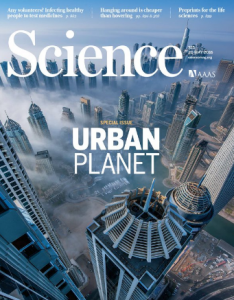 July 2016: A recent issue of the journal Science published a number of articles around the theme Urban Planet. One of the papers published was entitled: City-integrated renewable energy for urban sustainability (link to full text). The paper takes a high-level overview on a range of key carbon reduction opportunities at the city-level.
July 2016: A recent issue of the journal Science published a number of articles around the theme Urban Planet. One of the papers published was entitled: City-integrated renewable energy for urban sustainability (link to full text). The paper takes a high-level overview on a range of key carbon reduction opportunities at the city-level.
“To prepare for an urban influx of 2.5 billion people by 2050, it is critical to create cities that are low-carbon, resilient, and livable. Cities not only contribute to global climate change by emitting the majority of anthropogenic greenhouse gases but also are particularly vulnerable to the effects of climate change and extreme weather. We explore options for establishing sustainable energy systems by reducing energy consumption, particularly in the buildings and transportation sectors, and providing robust, decentralized, and renewable energy sources. Through technical advancements in power density, city-integrated renewable energy will be better suited to satisfy the high-energy demands of growing urban areas. Several economic, technical, behavioral, and political challenges need to be overcome for innovation to improve urban sustainability.”
Posted in Decentralised Energy, Energy Efficiency, Library, News, Renewable Energy, Uncategorized
Tagged Cities
Leave a comment
Air Quality implications of the London Energy Plan
April 2016: Think tank Policy Exchange has produced two reports over the past few months on London’s air quality crises (Up In the Air: How to solve London’s air quality crisis – Part 1 and Part 2). Though the bulk of the two studies are concerned with pollutants from the transport sector, the issue of emissions from London’s growing decentralised energy generation capacity also come under consideration.
Part 1 suggests that London’s support of decentralised energy systems, based around the GLA’s focus on the growth of gas fired Combined Heat and Power (CHP) plant, may exacerbate London’s air quality problems:
- The models also do not fully reflect the ongoing growth in decentralised power generation across London, including Combined Heat and Power (CHP). Decentralised energy is being promoted both by national government and the GLA, and there is now 195MW of CHP capacity across London (ranging from small units in homes to large units in industrial premises). Projections show that gas combustion in buildings could be responsible for 48% of NOx emissions by 2025 in Central London.14 There is a risk that measures to promote decentralised energy could increase local NOx emissions. [p7]
Part 2 goes on to recommend the following:
- We have also identified a risk associated with the growth of “decentralised energy” in London. Decentralised energy is being promoted by the GLA and DECC as a means to reduce carbon emissions and ensure security of supply. However, certain forms of decentralised energy produce significant NOx emissions, for example small scale gas and diesel engines, biomass boilers and CHP (Combined Heat and Power) installations. We recommend that the next Mayor of London reconsiders London’s Climate Change and Energy Strategy to reconcile the potential conflict between decentralised energy and air pollution. We also recommend changes to national energy policies led by DECC in order to resolve potential conflicts with local air pollution. [p8]
The issue of CHP and air quality has been looked at before, highlighted by campaigning group Clean Air London, and through guidance issued by the City of London and Environmental Protection UK
Hence, it is interesting to note that the GLA have recently approved “expenditure of up to £30,000 to procure and appoint consultancy services to model the air quality implications of the first four [London Energy Plan] energy plan scenarios... This study will deliver:
• A report detailing findings and recommendations
• Spatial maps showing the concentration of air pollutants estimated from the emissions rates of the heating technologies considered in the LEP.
• The dispersion of the air pollutants concentrations within the local area from the sources for four scenarios considered within the LEP.”
Posted in Decentralised Energy, News, Uncategorized
Tagged CHP, Decentralised Energy, London Energy Plan
Leave a comment
Why London’s next mayor should set up a municipal energy supply company
March 2016: An article on Citymetric by Jenny Jones of the London Assembly Green Party providing a useful summary of a report commissioned by her, and published in December 2015, looking at the opportunity for a new Mayor to set up a London municipal energy supply company.
Jenny Jones states that “my proposal would go beyond License Lite and instead establish a fully licensed not-for-profit energy supply business. This would manage TfL’s significant and growing electricity requirements, and extend supply services to London’s homes and businesses.”
This proposal was adopted this February by Green Party candidate for the London Mayoral 2016 election, Sian Berry, who has set out in a briefing note what a new London Energy Company would prioritise.
Posted in Decentralised Energy, News, Renewable Energy, Uncategorized
Tagged licence lite, Mayor2016, Photovoltaics
Leave a comment
Boris confronted on “1,620,000 loft/cavity retrofit target shortfall”
March 2016: …and so after eight years, we come to Boris’s last question time as London Mayor! And it’s good to see that energy and climate issues featured significantly yet again – a full list of which are posted here. In addition, a video has been posted online by London Assembly Green Party member Jenny Jones of her questions to the Mayor about a shortfall in his domestic energy efficiency programme RE:NEW.
And on that shortfall – Jenny Jones states that 95 per cent off the Mayor’s 1.7m home retrofit target has been missed with only 80,000 cavity and loft installations achieved out of a target set by the Mayor of 1.7 million. In response, the Mayor states:
- CO2 has reduced 14% since the programme began – in spite of London economic growth of 20%;
- London has significant challenges on insulation due to the low incidence of cavity wall homes and conservation areas;
- The Green Deal “wasn’t working well”
- To compensate he has recently introduced a London boiler scrappage scheme;
- After being called a “minnow” on London climate change action by Jenny Jones, when compared to other city leaders such as former New York Mayor Bloomberg and former California Governor Arnold Schwarzenegger, the Mayor responded that ‘he hasn’t been swanning off around the world on climate change junkets … to give good green sermons”
The Mayor’s 2011 Climate Change Mitigation and Energy Strategy actually states a 2015 target of retrofitting 1.2 million homes. And the June 2015 update to the Strategy sets out that “By the end of the 2013-14 financial year, over 100,000 homes were visited through the Mayor’s retrofit programmes. Coupled with wider market delivery, 500,000 home have been retrofitted across the capital”, this wider market delivery referring to the number of homes delivered through the Government’s ECO programme.
The disastrous cuts to ECO and failure of the Green Deal have dramatically reduced the effectiveness of the Mayor’s energy efficiency programme RE:NEW, a recent MQ stating that in “the 12 months from October 2014 RE:NEW supported the retrofit of over 4,500 homes.”
A lot depends on what is meant by retrofit: the initial phases of the RE:NEW programme visited homes on a specifically identified area basis, providing households with a number of free “easy measures”. These visits where meant to unlock additional, more significant, retrofit action in the visited households, such as the installation of loft, cavity or solid wall insulation. Follow up action by households was however fairly limited (only a few per cent) – as has been set out in the following research paper.
It’s clear from a recent MQ that the RE:NEW programme has been adversely impacted by the Government’s disastrous changes to its ECO programme, and the flawed nature of the Green Deal. The latest Government data shows that, despite the RE:NEW programme being in place to stimulate the uptake of energy efficiency in the capital, London still has the second lowest number of ECO measures installed (per 1,000 households) across UK regions.
Provisional number of households in receipt of ECO measures by region, up to 30th June 2015 (DECC spreadsheet)
Posted in Energy Efficiency, News, Uncategorized
Tagged Energy, insulation, RE:NEW, Solid Wall Insulation
Leave a comment
Energy and Climate Questions to the Mayor
March 2016: This month Mayor’s Question Time – the last in Boris Johnson’s eight year tenure as Mayor – once again included a wide range of questions on energy and climate, which included:
capturing waste heat from London Crossrail stations; the Mayor’s record on climate change; London based generators and Licenced Lite; the ability for Londoners connected to a district heating scheme to complain about poor service performance; anticipated prices of district energy heat tariffs; announcing the start of the Licence Lite programme; improvements in electricity export sales price for generators through Licence Lite; the number of Excess Winter Deaths amongst Londoners; challenges in promoting gasification technologies at the Olympic Park; the GLA’s Environment Team budget over the last 8 years; targets associated with the Boiler Scrappage Scheme; publication of London district energy schemes heat tariffs; the publication of London Energy Plan studies; guaranteeing that there are no plans for an incineration plan at Old Oak Common; the Mayor’s Boiler Scrappage scheme and fraud; RE:NEW energy efficiency retrofit programme delivery problems; how government energy efficiency programmes have helped Londoners; the amount of London’s (non transport) energy is supplied through local decentralised energy systems; cuts to the Energy Company Obligation (ECO); the Mayor’s recent meeting with the Secretary of State for Energy; the absence of London Fuel Poverty Strategy; the roll out of smart meters in London
Sutton district heating scheme; embodied carbon; annual progress on decentralised energy growth in London; anticipated savings from the new GLA boiler ‘cashback’ scheme; visits by the Mayor to RE:NEW energy efficiency retrofit projects; TfL future energy costs and the Mayor’s meeting with the National Infrastructure Commission.
Previous months questions to the Mayor can be found here.
Posted in Decentralised Energy, Energy Efficiency, News, Renewable Energy, Uncategorized
Tagged Community Heating, ECO, Fuel Poverty, licence lite, RE:NEW, Sutton, Transport, Waste
Leave a comment
4MW of PV added in London
March 2013: Ofgem’s new FIT quarterly report provides an update on the take-up of Feed in Tariff eligible technologies across the UK. London (as at 31 December 2012) has a total of 39.38 MW of FIT renewable capacity installed – as with the rest of the country, the vast proportion of this capacity is made up of PV (99% in London). This is an increase of 4.25 MW of capacity over the previous quarter.
Progress remains slow in London which – with the North East – trails all other UK regions by a significant margin. See graph from FIT report below highlighting the number of installations by region.
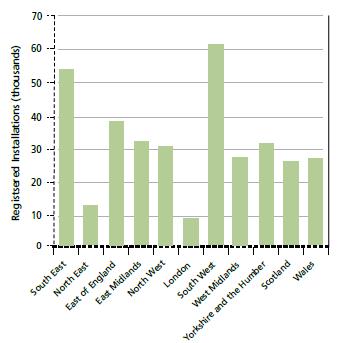 Previous posts discuss London’s slow performance on FIT take up here.
Previous posts discuss London’s slow performance on FIT take up here.
Excess Winter Mortality index figure highest in London
December 2012: The Office of National Statistics (ONS) last week issued its annual statistical bulletin with provisional figures of excess winter deaths (also referred to as excess winter mortality – EWM) in England and Wales for the winter period 2011/12, and final figures for the winter period 2010/11. Points to note include some important results in relation to London:
- In common with other countries, in England and Wales more people die in the winter than in the summer.
- EWM = winter deaths – average non-winter deaths
- There were an estimated 24,000 excess winter deaths in England and Wales in 2011/12 – an 8 per cent reduction compared with the previous winter.
- The regions of London, the South East and the East of England showed an increase in EWM between 2010/11 and 2011/12, with the largest percentage point increase occurring in London (2.0 percentage points higher)
- London also had the highest EWM index in 2011/12, with 18.9 per cent more deaths in winter compared with the non-winter period, compared with an average of 15.4 per cent for England and Wales
- Reference Table 2 shows that the increase in London occurred exclusively in people aged 85 and over. Furthermore, people aged 85 and over in London had the highest EWM index of any age group in any region.
- The Health Protection Agency reported that London had the highest level of influenza-like illness (ILI) within England and Wales (Health Protection Agency, 2012a), which may partly explain why this region also showed the highest level of excess winter mortality.
Direct link to the ONS bulletin here.
City Hall Fuel Poverty and Energy Efficiency session
5 November 2012: The London Assembly Health and Environment Committee are to hold a discussion session with a number of invited guests at 10am on Thursday 8 November at City Hall. Members of the public are able to attend these meetings. Amongst a range of issues, the meeting will consider the outputs of the Committee’s inquiry into fuel poverty carried out in 2011/12 and published in March of this year – In From the Cold.
Full details of the Commitee’s meeting are posted here, including a discussion paper for the session, which sets out that issues under consideration will include how:
- The GLA should establish criteria for areas to be selected for the next tranche of RE:NEW funding. This extension of the programme should prioritise households likely to be in severe fuel poverty.
- The GLA should in consultation with the energy companies and local authorities, develop an affordable warmth strategy for London.
A number of expert guests and stakeholders have been invited to participate in the discussion, including:
- Richard Blakeway, Deputy Mayor for Housing, Land and Property, and officers from the GLA;
- Amy Ingham, Fuel Poverty and Smart Meters team, Department for Energy and Climate Change;
- Jo Gill, Energy Efficiency Co-ordinator, LB Hillingdon and Vice-Chair of the inter-borough London Carbon Action Network;
- Christine Tate, Head of Corporate Social Responsibility, and Kelly Greer, Energy Solutions Manager, British Gas; and
- A representative from EDF Energy.
Carbon Visualisation
October 2012: A previous post highlighted how a campaign by the excellent Centre for Sustainable Energy managed to secure the release of a 40,000 dataset of public sector buildings Display Energy Certificates (DECs).
CSE have recently highlighted how this data has been used by a company called Carbon Visuals.
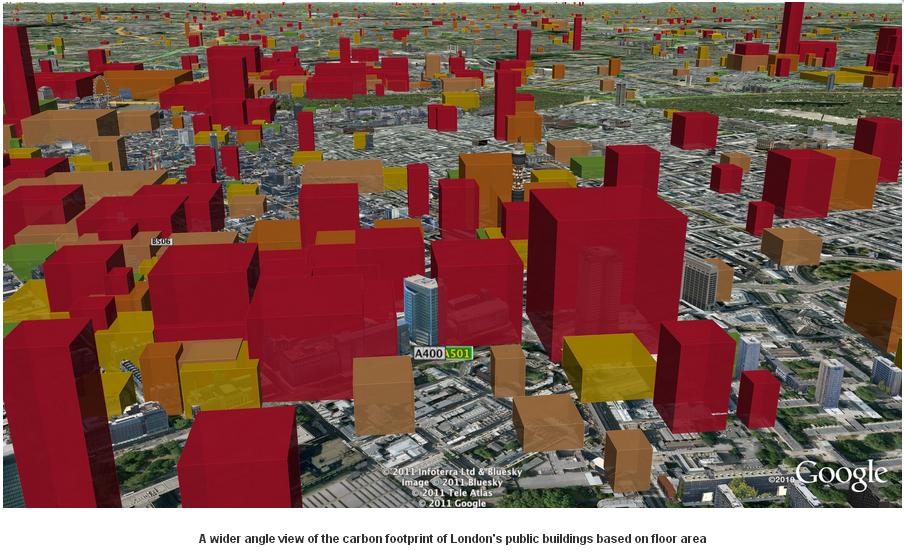
Some of the London building carbon data is illustrated above.
Carbon Visuals explain:
“With a grant from the UK’s Technology Strategy Board we have been exploring real-time visualisation and the visualisation of large data-sets. One of the results is an interactive visualisation of the carbon footprint of every public building in England and Wales – 40 thousand of them!
http://uk-energy-ratings.carbonvisuals.com/ The visualisation works in any browser that can run the Google Earth plugin but because the dataset is large, the plugin may perform sluggishly on slow computers. Or open in desktop version of Google Earth: http://uk-energy-ratings.carbonvisuals.com/kml/uk-emissions.kml “


